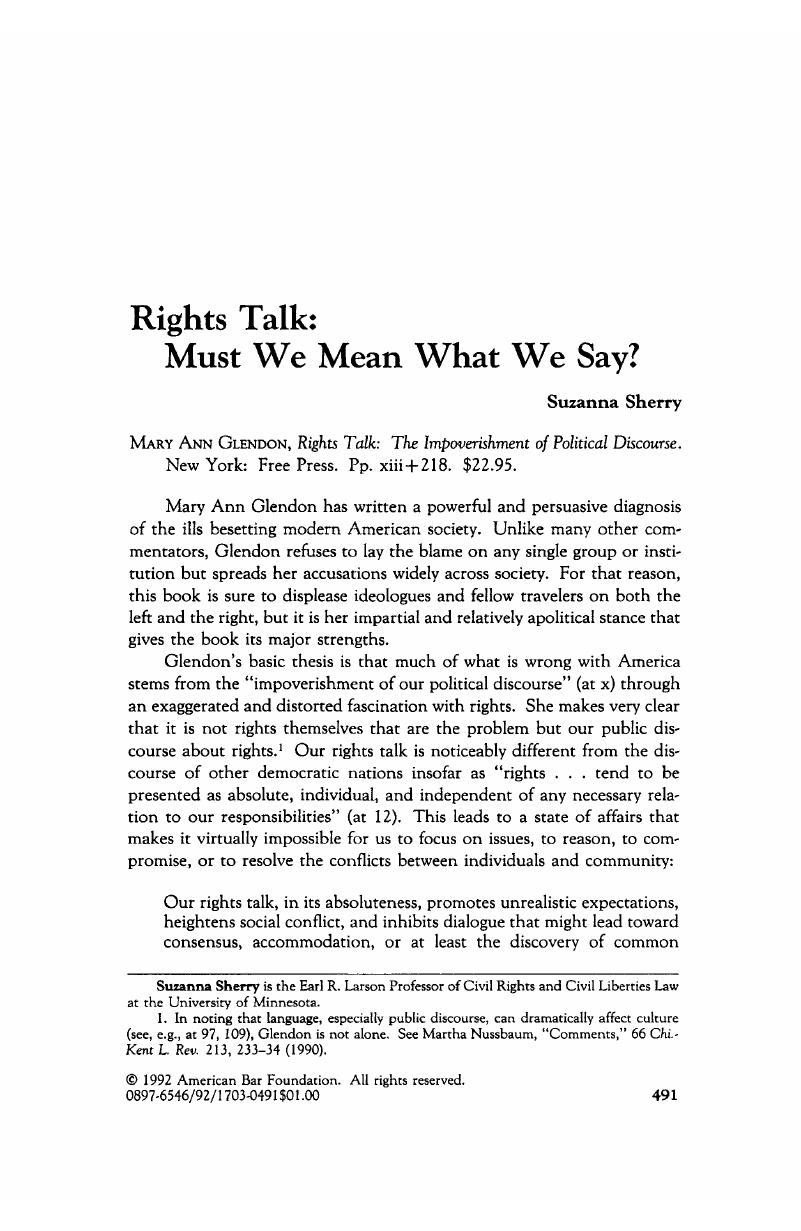No CrossRef data available.
Article contents
Rights Talk: Must We Mean What We Say?
Published online by Cambridge University Press: 27 December 2018
Abstract

- Type
- Review Essay
- Information
- Copyright
- Copyright © American Bar Foundation, 1992
References
1 In noting that language, especially public discourse, can dramatically affect culture (see, e.g., at 97, 109), Glendon is not alone. See Nussbaum, Martha, “Comments,” 66 Chi.-Kent L. Rev 213, 233–34 (1990).Google Scholar
2 She uses DeShaney v. Winnebago County Dept. of Social Services, 109 S. Ct. 998 (1989), To illustrate this point nicely. In particular, she suggests that the Court might have reached the same result in different language, thus avoiding the misleading appearance of a lack of obligations.Google Scholar
3 She also notes that where Americans rely on tort remedies, Europeans often see stranger-in-peril cases as “involving civic duties rather than private rights” and thus impose criminal rather than civil sanctions (at 84).Google Scholar
4 Richard Epstein suggests that the problem is not “rights talk” but the nature of the rights themselves: certain conflicts are simply not amenable to compromise, and discourse about them necessarily seems strident, absolutist, and radically individualist. Epstein, Richard A., “Rights and ‘Rights Talk,’” 105 Harv. L. Rev. 1106 (1992).CrossRefGoogle Scholar
5 Holmes, Oliver Wendell, “That Path of the Law,” 10 Harv. L Rev. 457, 458–59 (1897), discussed in Glendon at 86–87.Google Scholar
6 For various views on the interrelationship and possible conflicts among these different concepts, see, e.g., Mayer, David N., “The English Radical Whig Origins of American Constitutionalism,” 70 Wash. U.L.Q 131 (1992); Pangle, Thomas L., “The Classical Challenge to the American Constitution,” 66 Chi.-Kent L. Rev. 145 (1990); Sherry, Suzanna, “The Intellectual Origins of the Constitution: A Lawyers' Guide to Contemporary Historical Scholarship,” 5 Const. Commentary 323 (1988).Google Scholar
7 For some general overviews of civic republicanism and its modern implications, see, e.g., “Symposium: Classical Philosophy and the American Constitutional Order,” 66 Chi.-Kent L. Rev. 3 (1990); “Symposium: Roads Not Taken: Undercurrents of Republican Theory in Modern Constitutional Theory,” 85 Nw. U.L. Rev. 1 (1990); “Symposium: The Republican Civic Tradition,” 97 Yale L. J. 1493 (1988); Michelman, Frank, “Foreword: Traces of Self-Government,” 100 Harv. L. Rev. 4 (1986); Sherry, Suzanna, “Civic Virtue and the Feminine Voice in Constitutional Adjudication,” 72 Va. L. Rev. 543 (1986); Sunstein, Cass, “Legal Interference with Private Preferences,” 53 U. Chi. L. Rev. 1129 (1986); id., “Interest Groups in American Public Law,” 38 Stan. L. Rev. 29 (1985).Google Scholar
8 For general discussions of early American views of natural rights and their relationship to natural law, see, e.g., G. Edward White, History of the Supreme Court of the United States: The Marshall Court and Cultural Change, 1815–1835 at 676–77 (New York: Macmillan, 1988); “Symposium: Natural Law,”U. Cin. L. Rev. (forthcoming); Suzanna Sherry, “The Founders' Unwritten Constitution,” 54 U. Chi. L. Rev. 1127 (1987).Google Scholar
9 Amar, Akhil Reed, “The Bill of Rights as a Constitution,” 100 Yale L. J. 1131, 1132 (1991).CrossRefGoogle Scholar
10 See Katz, Stanley, “Thomas Jefferson and the Right to Property in Revolutionary America,” 19 J.L. & Econ 467 (1976); Alexander, Gregory S., “Takings and the Post-Modern Dialectic of Property,” 9 Const. Commentary 259 (1992).CrossRefGoogle Scholar




